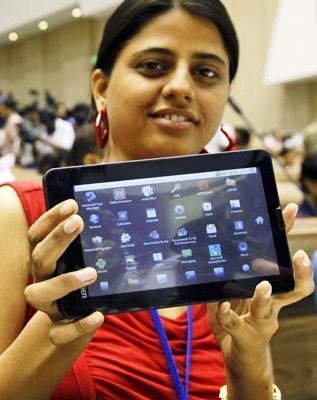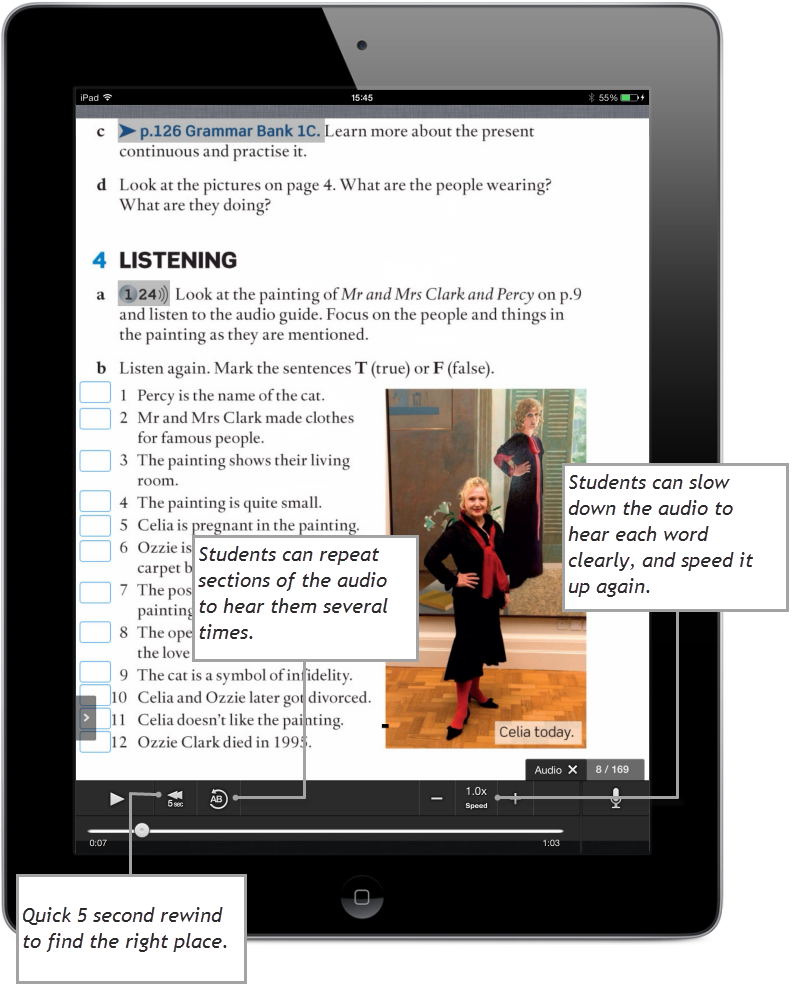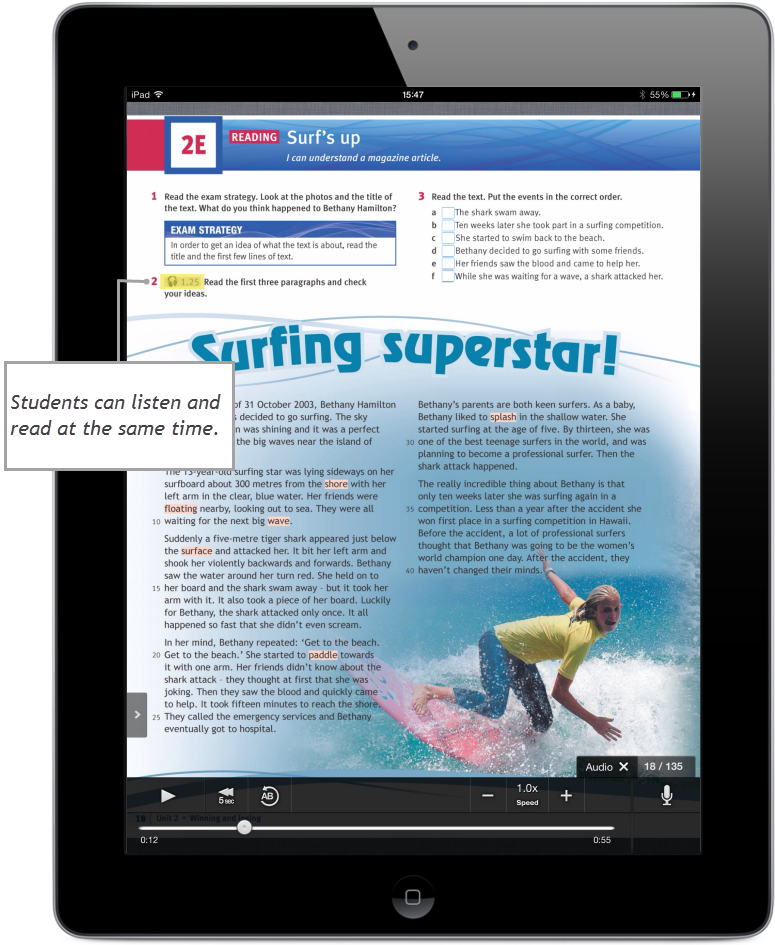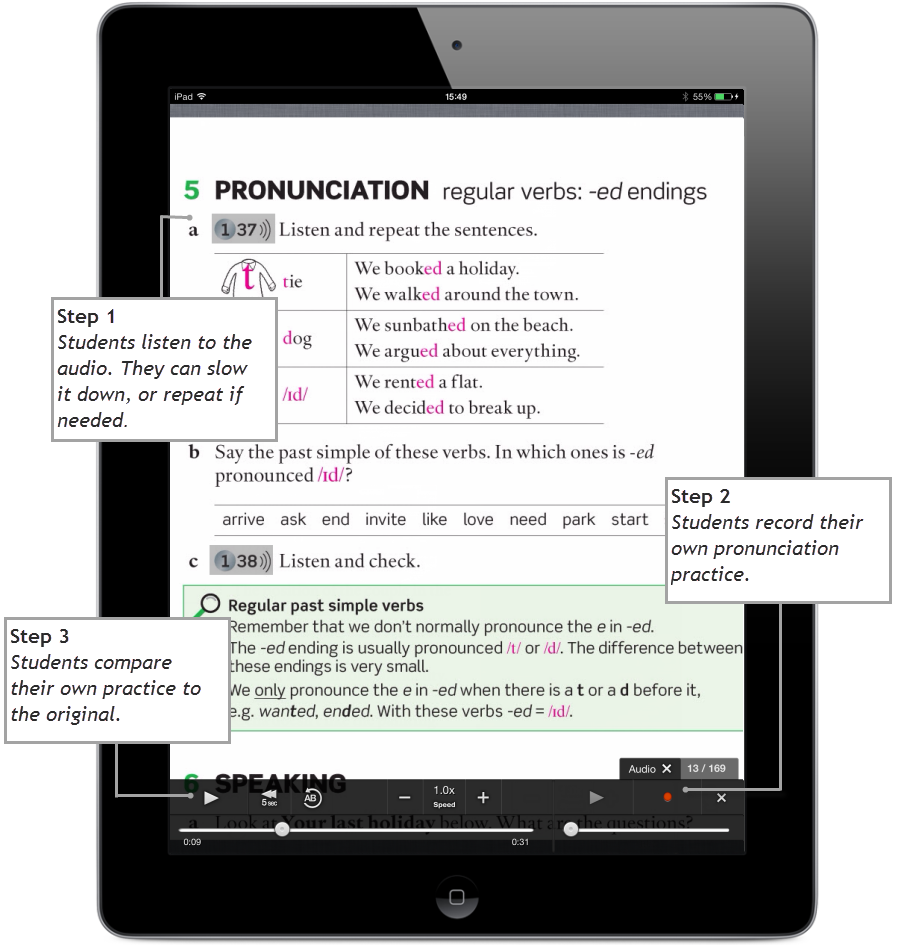 Shaun Wilden, a freelance teacher trainer and materials writer for OUP, considers how tablets and apps can help you encourage the less confident students in your class.
Shaun Wilden, a freelance teacher trainer and materials writer for OUP, considers how tablets and apps can help you encourage the less confident students in your class.
As a teacher trainer, I’ve often been asked how to deal with mixed ability classes. The asking teacher is generally of the opinion that mixed ability is something unusual. To me, it’s always seemed the norm, perhaps best summed up by this near twenty-year old quote.
We do not teach a group but (up to) thirty separate people. Because of this the problem of mixed abilities in the same room seems absolutely natural, and the idea of teaching a unitary lesson – that seems odd.”
Rinvolucri 1986, quoted in Podromou: Mixed Ability Classes
Mixed ability classes bring with them a whole manner of challenges for teachers to overcome. Students who perceive themselves as weak are often the ones that go unnoticed, the ones that are too shy to ask, the ones that don’t ask for the listening exercise to be played again and the ones who feel the pace of the lesson is too fast for them. Of course, should a teacher try and slow it down then those who are more confident complain the pace is too slow. Teachers have always been creative in finding ways to overcome the mixed ability issue. Be it through adjustment of course materials by subtle adaptations and grading or imaginative regroupings during exercises.
If, like me, you spend a large amount of your time reading about and using tablets in education, you’re bound to have run across the idea that tablets are the saviour to all things mixed ability. This, of course, is not true. However, perhaps tablets do offer some genuine alternatives for a teacher and their class. While we’re still a long way from most schools having class sets of devices, over the last couple of years we have seen a slow move towards tablet-based course materials. While some view this negatively, there are immediate advantages for the mixed ability class. Take for example, a listening lesson. Typically, such a lesson is more akin to a listening test.
The teacher establishes context, does a variety of pre-listening exercises and then presses play. Playing a few times but generally working with the class as a whole. Here’s where the mixed ability student falls behind: not getting all the answers and not asking for it to be played again. A tablet-based coursebook and set of headphones are a step towards overcoming this. Since every student has a copy of the listening, control can be handed over to them and they can listen as much as they like (and no one will know how much they needed to listen).

Staying on the topic of listening, adding audio to reading texts is another way to help some students. In a class you’ll have students who enjoy reading, some who enjoy listening and some who have difficulty with one or both. A tablet-based coursebook gives them the chance to do both, giving the students a choice they wouldn’t necessarily have. Having the choice makes such a task more amenable to a mixed ability class.

A tablet-based coursebook also gives every student a voice. Not literally, of course, but a voice when it comes to working with, for example, pronunciation. As a digital book can do more than simply have the printed word, the students at appropriate times can record themselves and listen to their own pronunciation when compared to a model. In a large class, it is difficult for a teacher to be able to hear and react to everyone. Recording also builds the student’s confidence as it acts as rehearsal time, so if they are then asked to say something in front of the class they feel more able to speak.

All these tools allow for self-pacing. The ability to work at one’s own pace is a key element of differentiated learning. However to be able to measure and then tailor learning, the teacher needs to be able to get feedback on how a student is doing. A tablet combined with cloud storage can add a digital equivalent to material adaptation; for example, a teacher can use a word processor to create individualised questions for a reading comprehension. Saving a copy of the questions for each student to access them, do the text and re-save via a cloud link on their tablet.
There are a number of apps that can be used on a tablet to achieve this. For example, Socrative, a student response system, is an app that allows a teacher to create exercises, quizzes and games that they can then get each student to do on their device. As they do it, Socrative gives feedback on each student and how they are doing. It provides the digital equivalent of ‘Do you understand?’. However, unlike when asking the question to the whole class, feedback is telling you exactly how each student is doing. Or to put it another way, the shy struggling student is not put on the spot in front of everyone. In a similar vein, an app such as Nearpod allows a teacher to create presentations that cater for a mixed ability classroom, creating lessons that include listening, video and presentations. The presentation is sent to the students’ device and while they are working the teacher can get instant feedback on how the student is doing.
Once a teacher has this feedback, they know who needs what help and where. They perhaps then can use a tablet’s screen recording ability to produce personalised instruction.
By this point you might be thinking that using the tablet in this way is turning the classroom from a place of communication into one where the students sit silently staring at tablet screens. However, that is assuming I am advocating these things are done for the whole lesson, which is not the case. In the listening, the individualised listening is a small portion of a larger lesson. With perhaps the pre- and post-listening tasks taking place as they usually would. Using the student response app is only done selectively, perhaps taking up only a few minutes of lesson time. Furthermore, such assumptions overlook a third way tablets can help address mixed ability: project work.
Project-based learning (PBL) is coming back into fashion as a result of what a tablet and its apps can do.
In most books on the subject of projects you’ll find reference to mixed ability:
…they allow learners with different levels of competence to co-operate on an equal basis in the completion of the tasks the project requires. This goes some way to solving the problems of mixed-ability classes.”
Projects with young learners: Phillips, Burwood and Dunford, p7.
Project work leads to personalisation – another factor known to help confidence in mixed ability classes. All tablets can record sound, take pictures, and record video, giving the students tools that were previously difficult to get either in or out of the classroom. Collaborative projects involving things such as podcasting, film making, and digital stories need more than language skills to be successful. They involve good direction, a steady hand with the camera and an eye for design, so those that lack confidence in language can gain it by bringing those skills to the project.
An article in the Times educational supplement lists three categories of differentiation to help deal with mixed ability:
- differentiation by task, which involves setting different tasks for pupils of different abilities
- differentiation by support, which means giving more help to certain pupils within the group
- differentiation by outcome, which involves setting open-ended tasks and allowing pupil response at different levels.
While teachers have been finding ways to do these things in the language classroom for years, using tablets can perhaps do this to levels previously never considered. Used effectively, and at the right moments in a lesson, they can help overcome what many teachers see as the difficulty of teaching mixed ability students.


[…] https://teachingenglishwithoxford.oup.com2013/12/10/how-tablet-devices-can-help-with-mixed-ability-classes […]
A thoughtful article however I must take issue with something you write. if students can listen and listen again in their own time to recordings then they are not practising listening they are just merely trying to get the answers right. It is bottom up listening skills that won’t help them when they leave the classroom. So actually although with a tablet and headphones it becomes more ‘akin’ to a test.
[…] "If, like me, you spend a large amount of your time reading about and using tablets in education, you’re bound to have run across the idea that tablets are the saviour to all things mixed ability. This, of course, is not true. However, perhaps tablets do offer some genuine alternatives for a teacher and their class. While we’re still a long way from most schools having class sets of devices, over the last couple of years we have seen a slow move towards tablet-based course materials. While some view this negatively, there are immediate advantages for the mixed ability class. Take for example, a listening lesson. Typically, such a lesson is more akin to a listening test." […]
[…] Shaun Wilden, a freelance teacher trainer and materials writer for OUP, considers how tablets and apps can help you encourage the less confident students in your class. As a teacher trainer, I’ve o… […]
[…] Imagine the success if each student had a tablet? […]